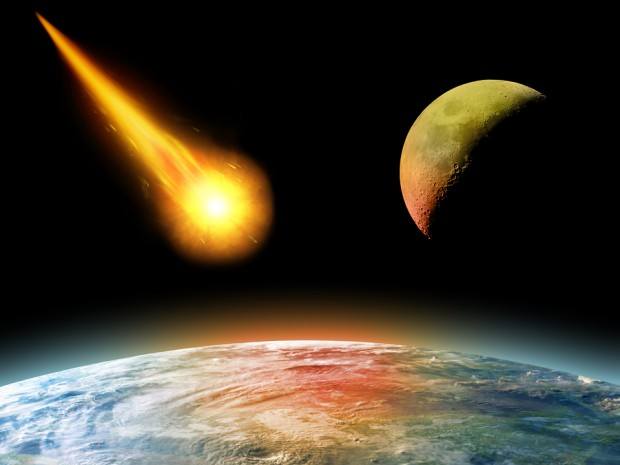On Feb. 15, a 13,000-ton rock plunged through the skies above Chelyabinsk, Russia. It shone 30 times brighter than the sun, and hurtled at 42,000 miles per hour toward a city of more than a million people.
As the rock broke apart during its fiery descent, it dispersed energy equivalent to 500 kilotons of TNT, shattering thousands of windows. Some 1,500 people were injured, and shock waves caused a ribbon of damage extending 55 miles on either side of the meteor’s path. Witnesses thought a nuclear war was upon them. Luckily, no one died.
This incident alone might not be cause to start worrying about death by asteroid. But new research suggests that space rocks as large as the one that fell over Chelyabinsk — about 19 meters (62 feet) across — are three to five times more numerous than scientists had realized. The study, led by Peter Brown at the University of Western Ontario, also found that larger and more dangerous ones are unexpectedly abundant.
In other words, alien projectiles pose a serious threat. Is it a manageable one?
For decades, astronomers have focused on the dangers posed by very large asteroids. Starting in 1998, NASA led an effort to catalog “near-Earth objects” at least a kilometer in diameter — big enough to cause a global catastrophe if they collided with Earth. About 90 percent of these have been identified. Yet smaller, Chelyabinsk-sized objects are harder to find. Scientists estimate there are more than a million of them nearby, and only about a thousand have so far been found. Locating and tracking every one isn’t practical. So what to do?
Astronomers at the University of Hawaii are working on one solution. Their system, called ATLAS, will deploy eight small telescopes to survey the entire sky twice each night in search of incoming asteroids, starting in 2015. ATLAS won’t peer as deeply into space as other detection systems — such as the Pan- STARRS facility, which hunts for “killer asteroids” that are decades from colliding with Earth — but it should find imminent threats more efficiently. If it works as planned, an international network of such systems could offer low-cost early warning.
The next question is how to prepare for any strike we see coming. Another new study, which analyzed the Chelyabinsk meteor’s trajectory and behavior in detail, should help. With better knowledge of how alien objects fall when they enter Earth’s atmosphere, it should be possible to determine the likely path of the next meteor, ensure people in harm’s way are informed or evacuated, and prepare an emergency response. With a few days’ warning in Chelyabinsk, officials could have urged residents simply to stay away from windows; shattered glass caused almost all the reported injuries.
Larger asteroids, though, remain a different story. NASA and other space watchers are making progress on their next goal of cataloging near-Earth objects larger than 140 meters, but the cosmos is still full of nasty surprises. In just the past few weeks, NASA has discovered three huge new space rocks, two of them initially estimated to be 20 kilometers wide. Although these won’t threaten Earth any time soon, the find was alarming. If such a behemoth was on a collision course with Earth, disaster planning wouldn’t be enough: We’d need a strategy for deflecting it.
With enough warning, that actually wouldn’t be so hard. NASA has suggested several plausible options, including hitting an incoming asteroid with a spacecraft or a nuclear weapon. Unfortunately, it’s hard to get people to take this idea seriously. (For one thing, it suffers by association with a lamentable Bruce Willis film.) And Congress has yet to designate responsibility for such a mission to any agency or take any other substantial steps to ensure the U.S. could react quickly to a potential threat.
The United Nations is starting to take the lead on that front. It’s helping countries coordinate their detection efforts, and its Committee on the Peaceful Uses of Outer Space is making plans to coordinate an international deflection mission. That’s precisely the kind of nuts-and-bolts bureaucratic preparation that’s needed to enable the world to respond rapidly.
And in a cosmos roiling with hazardous and unpredictable threats, preparation is the best defense we have.
–Editors: Timothy Lavin, Mary Duenwald.





















 California Bill Seeks to Add ‘Transparency’ to Aerial Images Used by Insurers
California Bill Seeks to Add ‘Transparency’ to Aerial Images Used by Insurers  Five AI Trends Reshaping Insurance in 2026
Five AI Trends Reshaping Insurance in 2026  Good Times for U.S. P/C Insurers May Not Last; Auto Challenges Ahead
Good Times for U.S. P/C Insurers May Not Last; Auto Challenges Ahead  $750K Chop Shop Theft Ring Busted in Arizona
$750K Chop Shop Theft Ring Busted in Arizona 



